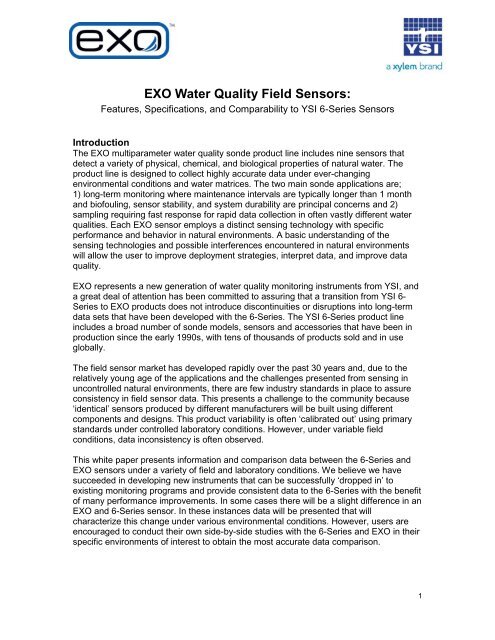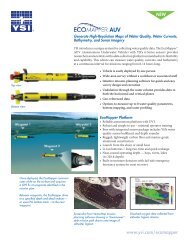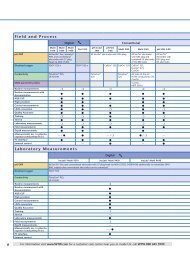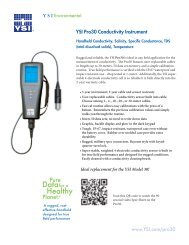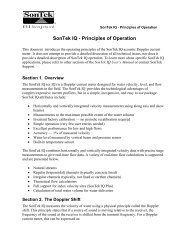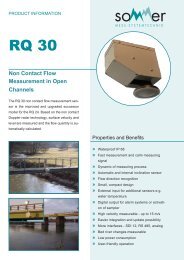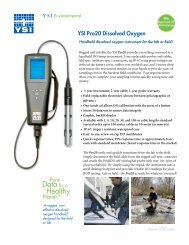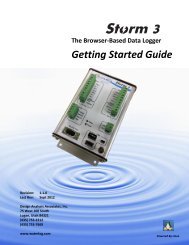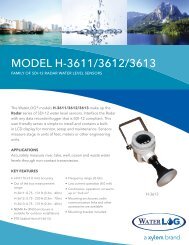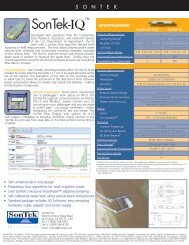EXO Water Quality Field Sensors - Xylem Analytics
EXO Water Quality Field Sensors - Xylem Analytics
EXO Water Quality Field Sensors - Xylem Analytics
Create successful ePaper yourself
Turn your PDF publications into a flip-book with our unique Google optimized e-Paper software.
Long-term side-by-side studies comparing water quality data collectedby <strong>EXO</strong> and 6-Series sondes in variable field conditions.Sensor PlatformAll <strong>EXO</strong> sensors are digital sensors with on-board signal processing and memory. Thisdigital platform offers many advantages to the user including: Improved detection limits and response times due to analog-to-digital electronicscontained close to sensing element, resulting in cleaner signals, reducedinterference, and faster signal processing.Auto-recognition of sensors by the sonde, eliminating potential for user errors.Sensor diagnostics, metadata and calibration data stored in sensors, allowing forcalibration in one sonde and transfer to other sondes.Each <strong>EXO</strong> sensor has an on-board thermistor that is used for temperature compensationand can also be used as a back-up thermistor in the event that the <strong>EXO</strong> CT sensor isdamaged or is missing. Because the sensor ports on <strong>EXO</strong> sondes are identical, usershave the ability to calibrate multiple of the same sensor type in one sonde and thendistributing calibrated sensors to other sondes, saving valuable time and money oncalibration standards.(Continued)2
Dissolved OxygenThe optical dissolved oxygen sensor available with the <strong>EXO</strong> system will show the sameexcellent accuracy (+/- 1% of the reading or 1% air-saturation) and stability for mostapplications (0-200% air-saturation; 0-20 mg/L) as the ROX sensor available on the 6-Series system. However, the <strong>EXO</strong> dissolved sensor shows significantly greateraccuracy (+/- 5% of the reading) than the ROX sensor (+/- 15% of the reading) in the200-500% air-saturation range (20-50 mg/L), so the <strong>EXO</strong> sensor will have an advantagein applications involving high biological productivity. The <strong>EXO</strong> sensor also is moreaccurate at depths greater than 30 m (100 feet) than the corresponding ROX sensor. Inaddition, the <strong>EXO</strong> sensor will have a response time which is approximately half that ofthe ROX sensor and this factor will be a significant advantage in profiling and samplingstudies. Overall, for most applications, users will see no difference in accuracy andstability in monitoring studies on transition between 6-Series and <strong>EXO</strong> systems, but thegreater accuracy at high oxygen levels and the faster response time will be significantadvantages.The <strong>EXO</strong> ODO sensor is constructed with titanium with a wet-mate connector. Themembrane cap includes titanium, sapphire glass, and proprietary ODO membranematerials.OPTICAL DO <strong>EXO</strong> 6-SeriesRange 0-500%, 0-50 mg/L 0-500%, 0-50 mg/L±1%, ±0.1 mg/L (0- 20 mg/L) ±1%, ±0.1 mg/L (0-20 mg/L)Accuracy±5%, ±0.5 mg/ (20-50 mg/L) ±15%, ±1.5 mg/L (20-50 mg/L)Response Time T63
ORPThe <strong>EXO</strong> ORP sensor will show equivalent accuracy and stability as the ORP sensor forthe 6-Series system. The <strong>EXO</strong> sensor may have a slightly faster response inenvironmental and process water applications, but this effect will likely be small. Inaddition, the <strong>EXO</strong> ORP sensor will automatically be mechanically cleaned in <strong>EXO</strong>2deployments without the use of any special wipers, etc. Overall, you should see nosignificant discontinuity on transition between ORP sensors in <strong>EXO</strong> and 6-seriessystems.ORP <strong>EXO</strong> 6-SeriesRange -999 to +999 mV -999 to +999 mV+/-20 mV in redox standardAccuracysolutions+/-20 mV in redox standard solutionsResponse Time T63
TURBIDITY <strong>EXO</strong> 6-SeriesRange 0-4000 FNU 0-1000 FNUAccuracy0.3 FNU or ±2% or reading w.i.g.(0-1000 FNU)±5% or reading (1000-4000 FNU) 0.3 FNU or ±2% or reading w.i.g.Response Time T63
Total Algae - ChlorophyllThe chlorophyll sensor for the <strong>EXO</strong> system is one component of the Total Algae probewhich also contains a blue-green algae (cyanobacteria) sensor. The <strong>EXO</strong> chlorophyllsensor operates on the same in vivo fluorescence principle as the 6-Series sensor withno disruption of the cells required to obtain either spot readings or long-term monitoringdata. The <strong>EXO</strong> sensor has a better detection limit than the 6-Series sensor asdetermined under laboratory conditions, and this advantage should be realized in manyfield applications. Like the 6-Series chlorophyll sensor, the <strong>EXO</strong> readings show excellentlinearity on serial dilution of a surrogate solution of Rhodamine WT (R 2 > 0.9998) andthis should ensure relative accuracy of field chlorophyll readings, i.e., a chlorophyllreading of 100 units will represent twice the algal content of water with a chlorophyllreading of 50 units.It is not possible to specify accuracy for chlorophyll and blue-green algae sensors due tothe variability of in vivo fluorescence from species to species, the effect of particle sizeand temperature on the sensor output, and the effect of ambient light on photosynthesis,which can also vary depending on deployment conditions and species variability. Also,like the 6-Series sensor, in order to obtain the best possible agreement between sensorreadings and those obtained after cell disruption and extraction of chlorophyll a, it will benecessary to actually calibrate the sensor in a medium of known algal chlorophyllcontent.The biggest advantage of the <strong>EXO</strong> chlorophyll sensor over the 6-Series version is thatthe <strong>EXO</strong> readings show much less interference from turbidity and dissolved organicsand this will allow for much more accurate determination of algal content under highturbidity conditions (i.e., a rainfall event) and in waters with high organic content (i.e.,stained waters and in bottom waters). For example, users of the 6-Series system wouldtypically see about 3 ug/L of chlorophyll interference in field water with a turbidity of 100NTU, but only about 0.5 ug/L of chlorophyll interference for the <strong>EXO</strong> sensor under thesame conditions. Overall the <strong>EXO</strong> sensor will show improved detection limits andresponse times, as good or better stability and lower noise levels as the current 6-Seriessensor. The <strong>EXO</strong> sensor offers a big improvement in rejecting the interference fromturbidity and dissolved organics, minimizing false positives and improving data accuracy.The <strong>EXO</strong> total algae sensor is constructed with titanium with a sapphire glass windowand wet-mate connector.CHLOROPHYLL <strong>EXO</strong> 6-SeriesRange 0-400ug/L 0-400ug/LMDL 0.07ug/L 0.5ug/LResponse Time T63
<strong>EXO</strong>Figure 6: Comparison of chlorophyll sensors of <strong>EXO</strong> and 6-Series in Miami River, OHover 48-day deployment. The turbidity data demonstrates <strong>EXO</strong>’s decreased sensitivityto turbidity interference from the 6-Series and other commercially available chlorophyllsensors.Total Algae - BGA-PCSimilar to the chlorophyll sensor described above, the phycocyanin-based blue-greenalgae (BGA-PC) sensor for <strong>EXO</strong> is one component of the total algae probe. Like the 6-Series BGA-PC sensor, the <strong>EXO</strong> readings show excellent linearity on serial dilution of asurrogate solution of Rhodamine WT (R 2 > 0.9997) and this should ensure relativeaccuracy of field BGA-PC readings, i.e., a BGA-PC reading of 100 units will representtwice the algal content of water with a BGA-PC reading of 50 units. A significantadvantage of the <strong>EXO</strong> BGA-PC sensor over the 6-Series version is that the <strong>EXO</strong>readings show less interference from turbidity and this will allow for much more accuratedetermination of BGA-PC content during rainfall events which release both sediment andalgae into the water. For example, users of the 6-Series system would typically seeabout 1500 cells/mL of BGA-PC interference in field water with turbidity of 100 NTU, butonly about half the interference for the <strong>EXO</strong> sensor under the same conditions.A note on units: YSI no longer offer the cells/ml unit for BGA sensors. The relationshipbetween fluorescent signal and cells/ml varies widely and use of the unit createdconfusion with customers and was often interpreted as a quantitative measure. Userswho want data reported in cells/ml will need to determine the fluorescence:cells/mlrelationship for an environment of interest and apply the correlation factor through apost-processing step. Units offered with include Relative Fluorescence Units (RFU), µg/L(estimate of phycocyanin pigment concentration), and the raw sensor output (RAW).Overall the <strong>EXO</strong> sensor should show the same good stability as the current 6-Seriessensor with lower detection limit, faster response time, and decreased sensitivity toturbidity and dissolved organic interference.10
BGA PC <strong>EXO</strong> 6-SeriesRange 0-100ug/L 0-200,000 cells/mlMDL 0.03ug/L 160 cells/mlResponse Time T63
fDOMThe fDOM sensor which is offered for use with the <strong>EXO</strong> sondes has no real analogy inthe 6-Series product line. (Note that it is possible to adapt a Turner Design CDOMCyclops probe to the 6-Series platform with the loss of an optical port, but the sensorcannot be calibrated, is not mechanically cleaned, and thus is not comparable to thefDOM sensor manufactured for the <strong>EXO</strong> platform). The <strong>EXO</strong> fDOM sensor measures thefraction of dissolved organic matter (DOM) which fluoresces (f) when exposed to highwavelengthultraviolet (UV) light (ca. 365 nm) and is comparable to other commerciallyavailable CDOM sensors but uses a more accurate naming convention. A surrogate forfDOM is quinine sulfate which, in acid solution, fluoresces similarly to dissolved organicmatter. The units of fDOM and (usually) CDOM are “quinine sulfate units (QSUs)” where1 QSU = 1 ppb quinine sulfate and thus quinine is really a “double surrogate” for thedesired CDOM parameter. The <strong>EXO</strong> fDOM sensor shows virtually perfect linearity R 2 =1.0000) on serial dilutions of a colorless solution of quinine sulfate. However, on serialdilution of stained water field samples, the sensor shows some underlinearity at levelsabove about 50 QSU due to the fact that the colored material in the water is absorbingsome of the UV light and reducing its ability to produce fluorescence. This underlinearityis common to all commercially available CDOM sensors and the impact should beevaluated in your environment of study to properly interpret the data. The <strong>EXO</strong> fDOMsensors exhibits very low detection limits and fast response times.The <strong>EXO</strong> fDOM sensor is constructed with titanium with a sapphire glass window andwet-mate connector.fDOM <strong>EXO</strong> 6-SeriesRange 0-300 ppb QSE NAAccuracy 0.03 ppb QSE NAResponse Time T63
Depth and LevelThe depth sensors (deep, medium, shallow, and shallow vented or level) offered with the<strong>EXO</strong> sonde are strain gauge sensors, which are very similar in theory and performanceto those offered with the 6-Series sondes. The sensors measure raw water pressure --psi absolute (psia) for the non-vented sensors and psi gauge (psig) for the vented –which is then converted into a depth-of-water value using the temperature and salinityreadings from the Conductivity/Temperature sensor. All <strong>EXO</strong> sensors exhibit improvedaccuracy to the 6-Series equivalent and this factor is their major advantage over the 6-Series. Also, there is a 250 m option on the <strong>EXO</strong> sondes, increasing the depth limitsfrom the 6-Series.DEPTH <strong>EXO</strong> 6-SeriesRange 0-10 m, 0-100 m, 0-250 m 0-9 m, 0-61 m, 0-200 mAccuracy ±4.0 mm, ±4.0 cm, ±10.0 cm ±20.0 mm, ±12.0 cm, ±30.0 cmVented Accuracy(0-10 m) ±3.0 mm ±3.0 mmResponse Time T63


